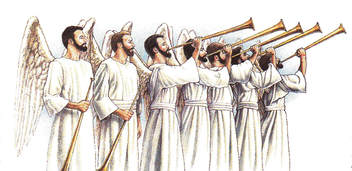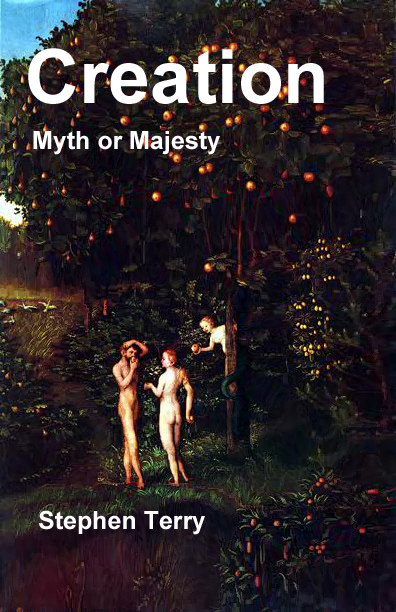
Stephen
Terry, Director

The
Seven Trumpets
Commentary
for the February 16, 2019 Sabbath School Lesson
 “When he opened the seventh seal, there was silence in heaven
for about half an hour. And I saw the seven angels who stand before God, and
seven trumpets were given to them.” Revelation 8:1-2,
NIV
“When he opened the seventh seal, there was silence in heaven
for about half an hour. And I saw the seven angels who stand before God, and
seven trumpets were given to them.” Revelation 8:1-2,
NIV
Our Sabbath School Quarterly this week covers an immense
amount of territory with myriad details to examine. Perhaps this is too big a
task caused by attempting to cover the entire book of Revelation in a single
quarter. Maybe this explains the rather poor supporting documentation this
week. For instance, in the lesson introduction, we are told a Jewish commentary
says thus and so, but we are not provided a cite for that
reference and are left with the implication that we must trust it anyway
because the lesson author said so which necessarily makes it true. This has
already proven suspect to a degree through the obvious belief that the
historicist interpretation of Revelation is the only possible one and therefore
must be holy and true. Strangely though, even the author abandons that model at
one point, perhaps hoping that no one will notice. As I previously noted in
earlier commentaries, the seven churches and the seven seals may just as easily
be understood as applying to the church concurrently in every age without the
need for the historicist’s imposition of a linear timeline of symbology to give
it meaning. Apparently, the author felt the same way when he wrote in the
lesson intro, “The scene of the fifth seal represents the experience of God’s
suffering people throughout history, from the time of Abel until the time when
God will finally judge…” Why he can see this for the fifth seal but nowhere
else is not clear. All of this is all the more puzzling because of the author’s
advanced degree which would normally require an appreciation of proper documentation
and a comparative exploration of alternative theories. Instead, we seem to find
pontification in lieu of scholasticism. I have great respect for the author and
prefer to assume that it was perhaps the heavy hand of the quarterly editor rather
than the author in this theological faux
pas.
I will not attempt a point-by-point examination of all
that this week’s lesson attempts to cover in Revelation. My commentaries are
far more limited in space than even the lesson quarterly. How could I then hope
to accomplish what even they could not satisfactorily achieve? Seventh-day
Adventist hermeneutics rest upon a very precise development of a historic
timeline of apocalyptic symbology in the two books of Daniel and Revelation.
This is exemplified in the early history of the denomination through the
writing of Uriah Smith, a former Review editor, in his book, “Daniel and the
Revelation.” Even though some major elements of his historicist application,
such as his references to the now defunct Ottoman Empire, have been tossed into
the dust bin of history, his historicist approach, as ancient things sometimes
do, has achieved a patina that makes it attractive, especially for those who
long for the golden days of yore when theological purity supposedly existed.
However attractive that might be, we may have fastened upon our wrists golden
shackles, restraints that so enthrall us that we find ourselves unable to
consider any other possibilities.
In a way, this is understandable for Daniel provides its
own interpretation which is clearly historicist to a point. Although we may
have some of that history wrong, especially in attempts to carry the model
forward into the future based on what Daniel has provided. Rather than go into
detail here, I would encourage you to read my commentary on Daniel, chapter 2.[i] You can reach it through
the link provided in the footnote. One theologian, Desmond Ford, who was
declared persona non grata and
defrocked by the General Conference after an inquisitorial hearing at Glacier
View Ranch in August of 1980,[ii] challenged the received
interpretation of portions of Daniel. The denominations extreme response is
indicative of how tenuous the historicist approach to apocalyptic literature
is. It is possible to construct a very precarious “house of cards” that may
collapse entirely if even a single element of the intricate structure fails to
pass muster. When that threatens, one may respond with a rejection of the
entire edifice, a rebuilding of the edifice with appropriate changes based on
new information, or a denial that the edifice needs any change and the
application of administrative “glue” to the cards to make sure they do not
collapse. Our denomination has at times chosen the latter course, and that has
painted us into a corner that seems to be increasingly growing smaller.
Even though our denominational pioneers were themselves young innovators who
were unafraid to challenge existing theological assumptions of their day, we
seem to have lost some of that appetite for discovery that thrilled their souls.
Instead of seeing their discoveries as stepping stones to continued advancement
toward exciting theological vistas, we have cast their discoveries in effigies
of stone as though handed down from Sinai. We challenge and declare as
apostates any who do not properly venerate those shibboleths. As a result, few
denominational leaders, whether lay or ordained, dare
explore anything that does not regurgitate the past for fear of losing their
position. This applies even more so to those actually in denominational employ.
The effect of this has been to turn our theologians into apologists which is
the only safe backwater of theology left to them where they may be free of molestation
by administrators or members who see themselves as guardians of the church’s
version of Orwellian Newspeak.
This all brings to mind the opening scenes of the gospel
of Matthew, chapter 24, where the disciples are admiring the beauty of the
temple, so carefully constructed over a lengthy period of time and at great
expense. How shocked they must have been to hear Jesus declare that it would
all be torn down, which indeed happened less than 40 years later. Some of the
shock the disciples likely felt may have been because the temple was the center
of worship and had been so for many centuries. Although this was not the temple
built by Solomon, it occupied the spot it had occupied. Even the ground it was
on was considered holy and still is venerated to this day as the Wailing Wall,
a place of prayer, even though the temple building proper no longer exists. Do
we look upon our intricate theological structure in the same way those
disciples looked upon the temple? Would we be as shocked if Jesus responded in
like manner?
Now, lest I be accused of not writing about those seven
angels in Revelation, I will offer up a non-historicist perspective. When we
consider the topics they are representing, environmental catastrophes and
plagues, we can perhaps see that these are not necessarily describing things
taking place at the far right of a linear timeline. These are representative of
processes that began long ago. The first dozen chapters of Genesis try to tell
us that. They describe the tendency of the human race to perpetuate a
self-destructive path. Eventually the focus narrows to Abram and his
descendants, but that story is based upon a foundation of human failing that eventually
becomes all too apparent in his family tree as well. The angels may simply
represent the completeness, as represented by the number seven, of the evil
humanity has brought upon the earth, and as humanity has multiplied so has that
evil. Every part of our world is bleeding and diseased if not already in its
death throws. The pain is palpable, and is not simply an End Time issue. Even
Paul could see it in his day, two millennia ago.[iii] The destruction of our
environment is rebounding on us in ways we do not even fully understand. It
seems few people manage to reach their senior years without autoimmune diseases
where the body, perhaps triggered by these environmental contaminants, does not
know how to respond and begins attacking itself.
But why is any of this important in regard to
Revelation? What does this have to do with the seven angels? Why is Historicism
problematic? The problem with Historicism is that it causes us to project all
of these concerns into an apocalyptic future when all of this is supposed to
happen. We either overlook the need to address these things in the present
either because we do not see them or because we believe that they are necessary
mileposts on the linear timeline that culminates in the Parousia. Therefore,
while regrettable, they are necessary evils. It is almost like we are saying with
our actions “Let evil abound so that grace may abound.”[iv] But such an attitude is
simply another way of believing that the end justifies the means. We are better
than that. We may not see it ourselves, but God sees it in us. That is why
Jesus incarnated and suffered the cross, to show us what we were created for.
God created us that we might exercise benevolent dominion over the earth with
him as suzerain. We were to be toward the earth as he is toward us. But we
surrendered that authority to another and the earth has been the worse for it
ever since. Even today, far too many have trouble accepting responsibility for
what we have wrought upon the planet and act as though it can accept any amount
of damage and will simply bounce back. While written in language that appears
to portray God as genocidal, maybe the story of Noah is simply an event in the
past when the earth no longer “bounced back” and mankind paid the price for his
stubborn selfishness. Jesu’; words about the end times being like the days of
Noah[v] may be a cryptic
recognition of that possibility.
